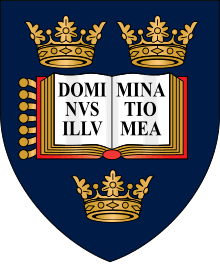St Anne's College, Oxford
| St Anne's College | ||||||||||||||||||||
|---|---|---|---|---|---|---|---|---|---|---|---|---|---|---|---|---|---|---|---|---|
| Oxford | ||||||||||||||||||||
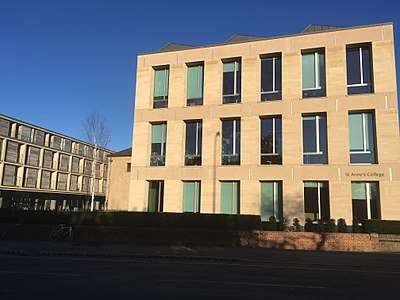 | ||||||||||||||||||||
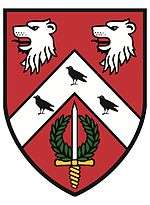 Blazon: Gules, on a chevron between in chief two lions heads erased argent, and in base a sword of the second pummelled and hilt or and enfiled with a wreath of laurel, three ravens, all proper. | ||||||||||||||||||||
|
| ||||||||||||||||||||
| Location | Woodstock Road and Banbury Road | |||||||||||||||||||
| Coordinates | 51°45′44″N 1°15′43″W / 51.762123°N 1.261974°WCoordinates: 51°45′44″N 1°15′43″W / 51.762123°N 1.261974°W | |||||||||||||||||||
| Latin name | Collegium Sanctae Annae | |||||||||||||||||||
| Motto |
Consulto et audacter (Purposefully and boldly) | |||||||||||||||||||
| Established | 1879 | |||||||||||||||||||
| Named for | Saint Anne | |||||||||||||||||||
| Previous names |
The Society of Oxford Home-Students (1879–1942) The St Anne's Society (1942–1952) | |||||||||||||||||||
| Sister college | Murray Edwards College, Cambridge | |||||||||||||||||||
| Principal | Helen King | |||||||||||||||||||
| Undergraduates | 444[1] | |||||||||||||||||||
| Postgraduates | 250[1] | |||||||||||||||||||
| Mascot | Beaver | |||||||||||||||||||
| Website |
www | |||||||||||||||||||
| Boat club | St Anne's Boat Club | |||||||||||||||||||
| Map | ||||||||||||||||||||
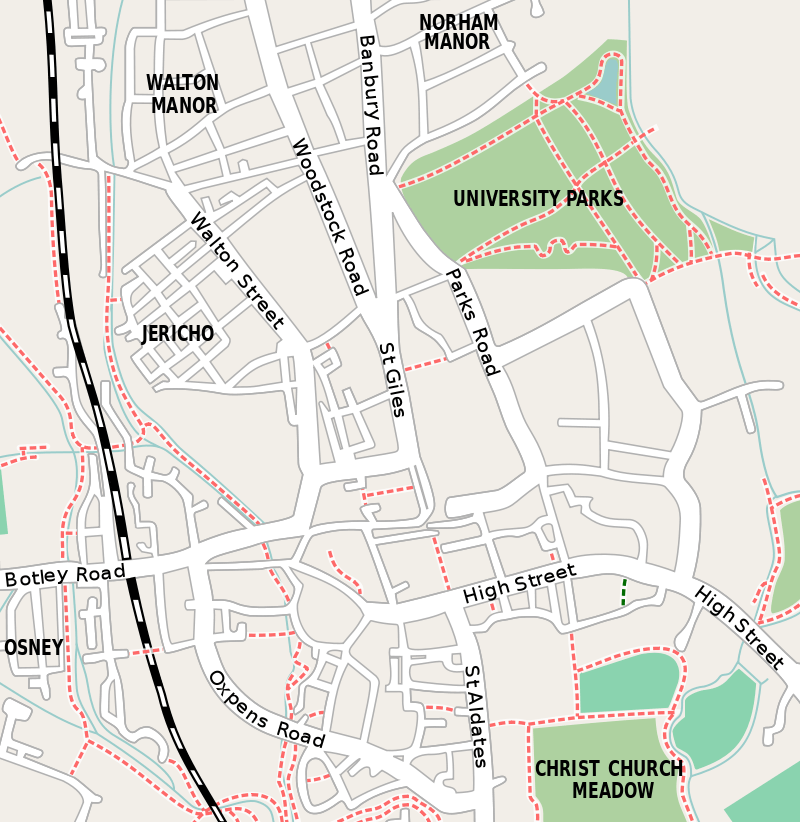 Location in Oxford city centre 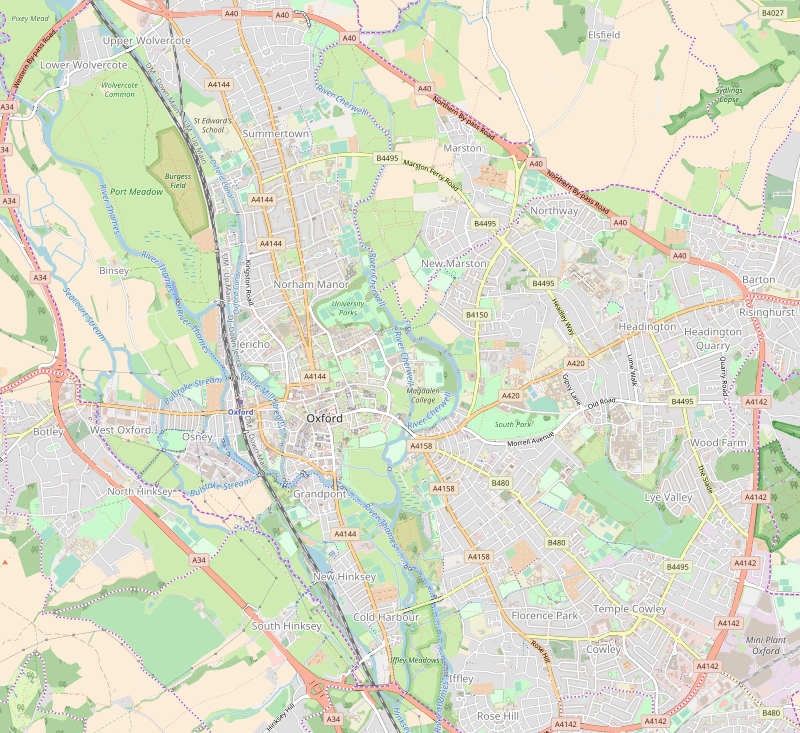 Location in Oxford | ||||||||||||||||||||
St Anne's College is one of the constituent colleges of the University of Oxford in England. Formerly a women's college, it has been coeducational since 1979.[2] Founded in 1879 as The Society of Oxford Home-Students, it received its college status in 1952, and today it is one of the larger colleges in Oxford, with around 450 undergraduate and 200 graduate students in a roughly equal mix of men and women. Its alumni include Ruth Deech, Danny Alexander, Helen Fielding, Simon Rattle, and Martha Kearney.
The college was established and expanded by the gradual acquisition of Victorian houses between the Woodstock and Banbury roads, with its location now in North Oxford and adjacent to the neighbourhoods of Jericho, Park Town, and Oxford University Parks.
In April 2017, Helen King took up her appointment as Principal, in succession to Tim Gardam. Helen King is a former Metropolitan Police Assistant Commissioner and was elected to the position of Principal upon her retirement from the police.[3][4] The 2016 annual review valued the college's endowment at £39 million.
History
What is now St Anne's College began life as part of the Association for the Education of Women, the first institution in Oxford to allow for the education of women (see: Lady Margaret Hall, Oxford), then later the Society of Oxford Home-Students.[5] In 1942, it became the St Anne's Society, and received a university charter to be founded as a women-only college in 1952. While it remains a common myth that it is built on land donated by St John's College, the site was acquired slowly by the purchase of existing houses and residences for the use of students.[6]
Early years – Society of Home Students (1879–1942)
What was to become St Anne's existed less as a location than an idea, with students living in lodgings across the city, rather than in a centralised location as today (many colleges own accommodation physically distant from their main grounds). The society allowed access to lectures and tutorials, as would any Oxford college. In 1910, the Society for Home Students, along with the other women's societies, were recognised by the University. In 1912, the society acquired its first tutors, in German, History and English Literature. In the 1920s, the principals of the Women's societies became the first women to receive degrees from the University. By the early 1930s, the society still had no centralised site. However, during this decade, the current site was chosen, and by 1937 construction of Hartland House was under way.[5]
St Anne's Society (1942–1952)
In 1942, the Society of Home Students was renamed the St Anne's Society, and given its coat of arms by Eleanor Plumer (Principal, 1940-1953).
St Anne's College (1952–)
In 1952, the St Anne's Society acquired a royal charter as St Anne's College and in 1959 full college status along with the other women's colleges.[7] The then Principal, Lady Ogilvie, pressed for a transition from many disparate dining rooms to a common building. This resulted in the construction of the dining hall, which was completed in 1959, and visited by Queen Elizabeth II in 1960. During this period, the student numbers grew to nearly 300, leading to a need to construct more accommodation. This led to the construction of the Wolfson and Rayne buildings in 1964 and 1968 respectively. In 1977, the decision was made to become coeducational, with the first male undergraduates matriculating in 1979.[8]
Since then, St Anne's has continued to use female words and pronouns to refer to their students, as in the word "alumnae". The College explains that this is because "on 17 June 1979, in the nervous time when the first male Fellows had been elected, and the first male students admitted though they had not yet arrived, a note from the Dean to Governing Body asks hesitantly 'Would Governing Body wish "he" (or "he/she") to be substituted for "she" throughout the College Regulations?' Eventually the question was answered (or perhaps avoided) with the following carefully worded statement which still stands in the preamble to our Regulations: 'words importing the feminine gender shall include the masculine and vice versa, where the construction so permits and the Regulations do not otherwise expressly provide'."[9]
The Ship
The annual magazine for alumni of the college is known as The Ship.[10] When it was still known as the Society for Home Students, the college had its first common room in Ship Street, located in central Oxford.[5] The Ship started to be published c. 1910, and by the centenary of the college, 1979, there had been 69 issues.[11] The Ship celebrated its centenary 2010/2011 issue with some anniversary content.[12]
Location and buildings
| Map of the University of Oxford | |||||||||||
|---|---|---|---|---|---|---|---|---|---|---|---|
| |||||||||||
 1 2 3 4 5 6 | |||||||||||
Facilities
| |||||||||||
Accommodation
| |||||||||||
Grounds
Its grounds are bounded by Woodstock Road and Banbury Road to the west and east respectively, and Bevington Road to the north. They extend as far south as 48 Woodstock Road on the west, and 27 Banbury Road on the east side. The College formerly owned a number of houses throughout Oxford used for undergraduate accommodation, some formerly boarding houses of the Society of Oxford Home-Students; these have been largely sold off to fund the building of the Ruth Deech Building, completed in 2005. These grounds house all of the college's administrative and academic buildings, undergraduate accommodation, as well as the hall, which is among the largest in Oxford.
Undergraduate accommodation
St Anne's can accommodate undergraduates for three years of study. Undergraduates at St Anne's are housed in 14 Victorian houses owned by the college and four purpose-built accommodation blocks. The bulk of the Victorian housing consists of 1–10 Bevington Road, With 10 Bevington Road housing the junior post room. Adjoining Bevington Road, the 58/60 Woodstock Road accommodation hosts the launderette for students, and also a rowing practice room. As such, these buildings are open between 08:00 and 21:00 for student access to all, unlike most accommodation, which is electronically locked to all but residents and staff. Likewise, 39/41 Banbury Road hosts the college bar, open to all students until 23:00. The accommodation in this building is referred to as "Above The Bar (ATB)".. The purpose-built accommodation blocks include the Wolfson, Rayne, Claire Palley, and Ruth Deech buildings, along with Treneman House. A further building, the Eleanor Plumer House, serves postgraduates.[13] Treneman House is host to the St Anne's Coffee Shop, known as "STACS", which is a unique feature of the college, and open to undergraduates and postgraduates alike.[13]
Hartland House

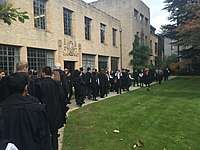
The Hartland House, designed by Sir Giles Gilbert Scott, was the first purpose-built college building, finished in 1937 with an additional wing built in 1973. It now houses the old Library (largely humanities), the junior and senior common rooms, and administrative offices.
Junior Common Room
The Junior Common Room is a room within Hartland House, although the term is also used to refer to the corresponding student political body of undergraduates.[14]
Library
The Hartland House Library covers books from 700 to 999 on the Dewey Decimal System.[15] This corresponds to the Arts and Humanities,[15] however, the library also includes a section on Law, with a corresponding shelfmark of 342.[15]
Ruth Deech Building
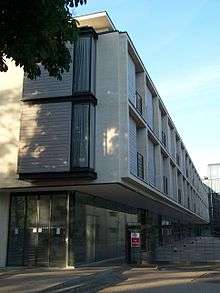
The Ruth Deech Building was completed in 2005.[16] It houses extensive conference facilities (the Tsuzuki lecture theatre, seminar rooms, and dining facilities) on the lower ground floor, in addition to the new College Porter's Lodge on the upper ground floor, and 110 en-suite student rooms.[17] One of the notable features of the building is the glass lift, which is the only part of the building to exceed the roof line.[18] The building was awarded the 2007 David Steel sustainable building award by Oxford City Council.[19]
New library and academic centre
The new library and academic centre, completed in 2016, is on the site of the former Founders' Gatehouse, which was built in 1966 and was the college lodge until 2005. It also covers the area previously occupied by the 54 Woodstock road cottage.[20][21]
Rayne and Wolfson Buildings
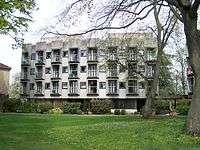
The Rayne and Wolfson Buildings were built in 1964 and are Grade II Listed Buildings; they are virtually identical in design, and house administrative offices on the ground floor as well as student rooms.
Claire Palley Building
The Claire Palley Building, completed in 1992 and named after former Principal Claire Palley, was the first accommodation block to have en-suite rooms. It also houses the Mary Ogilvie Lecture Theatre.
Trenaman House
Trenaman House, built in 1995, holds student rooms as well as communal college facilities on the ground floor and, since 2008, the St Anne's Coffee Shop (STACS). It was named after Nancy Trenaman, the sixth Principal of the college (1966–1984).
Dining Hall
The Dining Hall, built in 1959, is amongst the largest in Oxford with a capacity of 300. Three meals are served daily in hall apart from on weekends when only brunch is served. It is also used for college collections (internal college exams) and, on occasion, college 'bops' (costume parties).
Other facilities
The Eleanor Plumer House (known until 2008 as simply 35 Banbury Road) houses the Middle Common Room, and attached facilities including a study area/computer room and kitchen, in addition to accommodation for graduate students. Five additional Victorian houses (27, 29, & 37 Banbury, and 48 & 50 Woodstock) hold teaching rooms, seminar rooms, music practice rooms, and college offices.
Robert Saunders House
The Robert Saunders House, built in 1996, provides 80 rooms for post-graduate students in Summertown, an area in the north of Oxford. It was named after a former bursar of the college, who did much to strengthen its finances.
Traditions
The college has relatively few traditions and is rare amongst Oxford colleges in not having a chapel (along with St Catherine's College and Kellogg College). Formal hall is held fortnightly. Gowns are not usually worn, except for official university occasions such as matriculation and certain college feasts. The college mascot is a beaver.
College grace
The college grace was composed by former classics tutor and founding fellow, Margaret Hubbard. It involves the Principal reciting the Latin words Quas decet, (deo) gratias agamus. Amen. The inclusion of deo (to God) depends on whether the grace is religious or secular in nature.
Room ballot
The College selects accommodation using a room ballot, with the exception of the first years. (To be) fourth years select their rooms on the first day, followed by third year rooms on the second day, and finally second year rooms on the final day. Each student is allocated a number denoting their position in the ballot, within their year. This allocation is done on the basis of the (perceived) quality of their previous year's accommodation. Students then queue, and rooms are allocated one by one. As a room is allocated, it is crossed off a large board listing all available rooms. There is then a period of one week after the ballot where students are allowed to organize mutually agreed swaps.
Sport and societies
The college has teams for all major sports, and competes in inter-collegiate "cuppers" tournaments. Fixtures are either played in the neighbouring University Parks, or in the college playing fields on Woodstock Road. St Anne's College Boat Club (SABC) organises the college's involvement in inter-college rowing events, and the college boathouse, situated on the River Isis in Christ Church Meadow is shared with St Hugh's and Wadham colleges. The college has a joint rugby team with St John's College, which won Cuppers in 2014.[22][23]
There is a lot of music-making in the college, with opportunities for singers and instrumental players to be involved in ensembles. In keeping with its secular outlook, there is no sacred choral singing in St Anne's, but there is an informal a cappella group that rehearses weekly, known as Stacappella. The group performs versions of popular and folk songs arranged by music students, and is currently directed by Joseph Fell. The college's Director of Music is Dr John Traill, who runs a regular professional recital series and a string orchestra in the college.
The college's geology society, STAGS (St Anne's Geology Society), is a hub of social gatherings for the college's Earth Sciences students. The college's classics society organises a joint symposium with Brasenose College every term, as well as a biennial trip to Lamledra, Cornwall.
Notable people
Alumnae
- Sir Danny Alexander – Liberal Democrat politician
- Dame Rosemary Cramp, DBE, FBA – archaeologist
- Helen Fielding – novelist
- Penelope Lively, CBE, FRSL – novelist
- Melanie Phillips – journalist and author
- Polly Toynbee – journalist and writer
- Jill Paton Walsh, CBE - novelist
- John Robins - comedian and radio presenter
Academics
- Peter Donnelly, FRS
- Georg Gottlob, FRS
- Nancy Hubbard
- Tony Judt, FBA
- Dame Iris Murdoch
Gallery
 37 Banbury Road, containing offices of Fellows of the College
37 Banbury Road, containing offices of Fellows of the College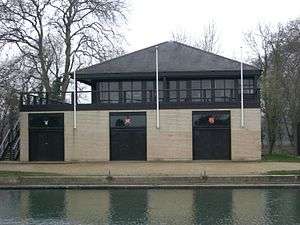
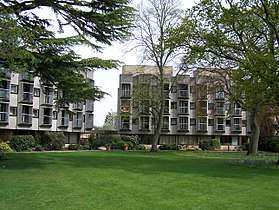 The Rayne Building viewed from the quadrangle
The Rayne Building viewed from the quadrangle The Gatehouse, which was demolished in the 2014–15 academic year
The Gatehouse, which was demolished in the 2014–15 academic year%2C_St_Anne's_College%2C_University_of_Oxford.jpg) The rear of Trenaman House viewed from the Bevington Road garden
The rear of Trenaman House viewed from the Bevington Road garden%2C_St_Anne's_College%2C_University_of_Oxford.jpg) Trenaman House (Upper) containing St Anne's Coffee Shop (STACS) and some undergraduate accommodation
Trenaman House (Upper) containing St Anne's Coffee Shop (STACS) and some undergraduate accommodation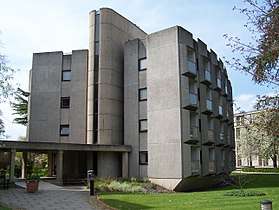 Wolfson Building
Wolfson Building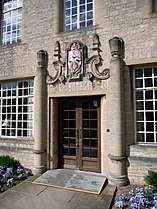 The main entrance to Hartland House, with the college's coat of arms and motto
The main entrance to Hartland House, with the college's coat of arms and motto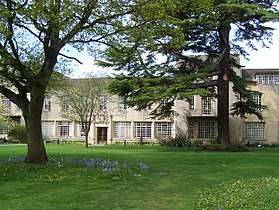 Hartland House in its parkland setting
Hartland House in its parkland setting The New Library and Academic Centre, St Anne's College
The New Library and Academic Centre, St Anne's College Bevington Road
Bevington Road
References
- 1 2 "Welcome to St Anne's". St Anne's College. 2008. Retrieved 31 January 2011.
- ↑ "Statement of Values". About St Anne's College. St Anne's College. 2009. Retrieved 24 May 2010.
- ↑ "Met assistant commissioner announces retirement - UK Police News - Police Oracle". www.policeoracle.com.
- ↑ "St Anne's College, Oxford > About the College > Helen King elected as Principal of St Anne's College". www.st-annes.ox.ac.uk.
- 1 2 3 "St Anne's History". About St Anne's College. St Anne's College, Oxford. Retrieved 2 June 2011.
- ↑ http://www.st-annes.ox.ac.uk/fileadmin/STA/Documents/History/s_History_pdf.pdf
- ↑ "St Anne's History Brochure" (PDF). st-annes.ox.ac.uk. Retrieved 2 October 2018.
Only in 1959 did the five women’s colleges acquire full collegiate status so that their councils became governing bodies and they were, like the men’s colleges, fully self-governing.
- ↑ http://www-dev.st-annes.ox.ac.uk/fileadmin/documents/Publications/St._Annes_History_Brochure_David_Smith.pdf
- ↑ "St Anne's College, Oxford > Alumnæ & friends > Our alumnæ". www.st-annes.ox.ac.uk. Retrieved 2018-10-04.
- ↑ "The Ship". Alumnae & Friends. St Anne's College, Oxford. Retrieved 2 June 2011.
- ↑ "The Ship". The Ship. St Anne's College. 1979.
- ↑ "The Ship". The Ship. St Anne's College. 2011.
- 1 2 "St Anne's College, Oxford > About The College > Buildings and Grounds".
- ↑ "Junior Common Room (JCR)". St Anne's College. Retrieved 6 February 2018.
- 1 2 3 "St Anne's College Library: Home". Bodleian Library. 5 February 2018. Retrieved 6 February 2018.
- ↑ "St Anne's College Opens New Building" (PDF). Conference Oxford Newsletter. Retrieved 28 April 2008.
- ↑ "Ruth Deech Building, St Anne's College". AKT II. Retrieved 8 February 2018.
- ↑ Laura Salmi (10 November 2008). "New school meets old school". World Architecture News. Retrieved 8 February 2018.
- ↑ "David Steel Sustainable Buildings Award". Oxford City Council. Retrieved 8 February 2018.
- ↑ "Library and Academic Centre, St Anne's College". ridge.co.uk.
- ↑ "St Anne's College, Oxford > Alumnæ & friends > New Library and Academic Centre". www.st-annes.ox.ac.uk.
- ↑ "Saints Win Cuppers In Dramatic Finale". ourfc.org.
- ↑ "Saints stun Teddy Hall in last gasp Cuppers victory". Cherwell.org.
External links
| Wikimedia Commons has media related to St Anne's College, Oxford. |
